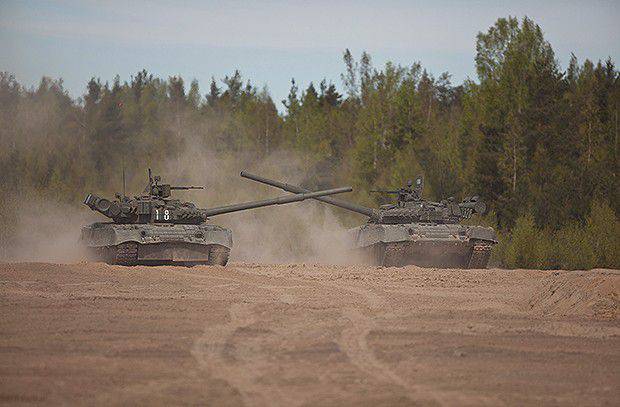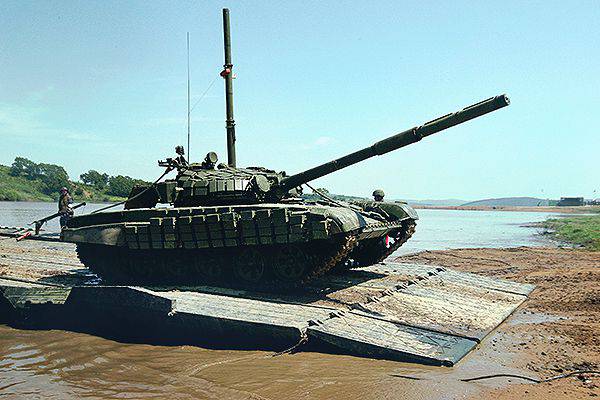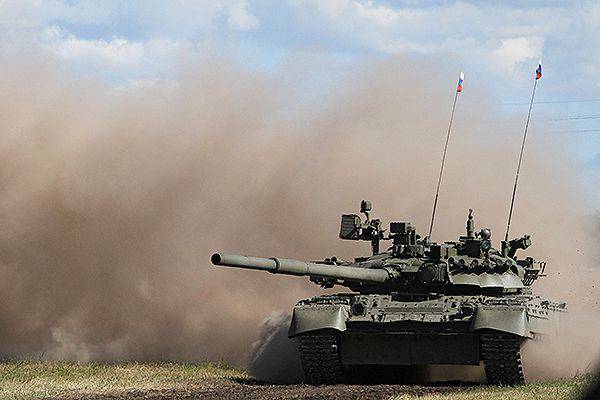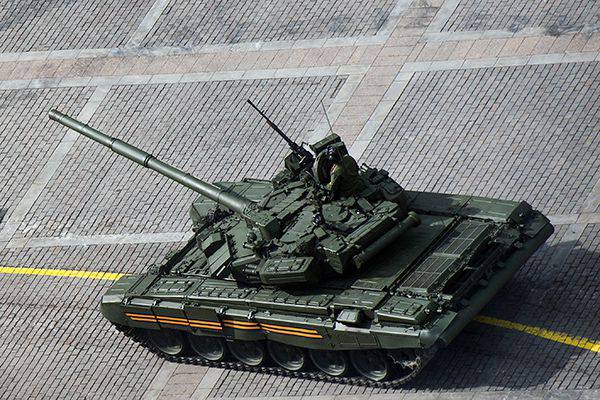What tanks are in service with the Russian army

Basis tank of Russian troops are machines that have proven themselves in all notable conflicts of the past four decades
Since the Second World War, tanks have been and remain one of the main active forces in conflicts with direct contact of opponents - so to speak, the main heavy weapons on the battlefield. Naturally, therefore, the number of tank forces also remains one of the most important indicators of the combat capabilities of the army of a given state.
Among the world powers, the largest tank forces have three: the Russian Federation, the United States and China, and in this troika our country leads with a huge margin. To date, according to various data, in existing troops and in storage in the arsenals of the Russian army, there are about 21 000 – 22 000 tanks. American tank forces are armed with half the number of vehicles - 9125 units, of which the vast majority (about 8700) are the Abrams МХNUMX adopted almost a quarter of a century ago. A comparable number of tanks, according to various sources - from 1 to 8500 pieces, has the People’s Liberation Army of China, where the “Type 9000” tank, adopted in 96, prevails and, in its combat capabilities, is closest to the latest T-1997 of the last modifications .
That it is the Russian army that possesses the largest number of tanks in the world is not surprising. After all, our country has the longest land border in the world, and besides, all the wars of the last two centuries, including two world wars, Russia was forced to conduct mainly on its own territory. In such conditions, the concept of the use of armed forces must inevitably largely rely on tank forces - just as the American concept of war in foreign territory overseas relies on aircraft carriers and mobile forces such as marines.
In the ranks and in stock
Formally, as the official website of the Ministry of Defense of the Russian Federation says, three models of tanks are in service with domestic tank forces: T-72, T-80 and T-90. Their number does not include the Armata T-14, the newest T-13 tank, which was recently officially demonstrated to the public at the Victory Parade in Moscow. There are no official data on the number of tanks of each model of the Ministry of Defense, but, according to independent sources, the total number of vehicles of all three models reaches 000 14 – 000 XNUMX pieces.
In addition, the official military site does not mention the tanks stored in the reserve - outdated, but not lost their combat capabilities T-55, T-62 and T-64. And they are not so little - almost 8000. Most reserved tanks T-55: after all, this is the most massive Soviet post-war tank of the first generation. Adopted in the 1958 year, this armored vehicle only in the USSR and only in the main modifications was released in quantities over 20 000 pieces! Most of them, of course, have already been disposed of, but roughly 2800 T-55 are stored in storage tanks.
Slightly less - about 2300 units - canned T-64 tanks. This machine turned out to be very successful, despite its low modernization potential, and in the West its appearance was generally compared with the appearance on the battlefield of the famous T-34. But the predecessor and contemporary of the T-64 - the T-62 tank - was preserved in the arsenals in much smaller quantities: approximately 1600 units. More recently, they were almost 2500, but 900 machines were recycled, despite the fact that the weapons of the T-62 finally removed only in the 2011 year.
The main tank T-72 "Ural"
The number of tanks in service: about 2000 units
The total number of tanks produced all modifications: about 30 000 units (approximately 7500 units are in storage)
Weight: 41 t
Armament: 125-mm cannon, machine gun caliber 12,7 mm, machine gun caliber 7,62 mm
Crew: 3 person
Rough ground speed: 35 – 45 km / h

T-72 can be considered the most massive Soviet post-war tank of all generations, which is natural: it was adopted by 7 August 1973, the same year the installation batch was released in 30 machines, and the model was discontinued only in 2005, i.e. 32 a year later! The chief designer of the tank, Leonid Kartsev, noted that foreign experts consider this car "the best and most massive tank of the second half of the twentieth century."
For three decades, the tank has been repeatedly upgraded: the total number of modifications, including export versions, reaches two dozen. But the main modifications were T-72A and T-72B, as well as more modern T-72BA and T-72B3. The first modification, the T-72A, was carried out in the 1979 year: new guidance and observation devices were installed on the machine, the gun was replaced with a newer one, and the hinged protection was strengthened, and the engine was changed to a more powerful one. Six years later, a modification of the T-72B appeared - with the new Svir guided weapon system, the new Kontakt dynamic protection system and a new engine, as well as a gun - a launcher instead of the usual gun.
The third modification is a deep modernization of T-72B with increased protection, including built-in dynamic, and more modern elements of the fire control system and the tank itself. And the last modification, the T-72B3, has been deployed to the troops for the last three years and is distinguished by its newest fire control system, which significantly increased the capabilities of on-board armament, the most powerful engine in the entire lineup, and an improved undercarriage.
Main tank T-80
Number of tanks in service: around 4000
The total number of tanks produced all modifications: more than 10 000 pieces (of which over 6500 - modification of the T-80)
Weight: 42 – 46 t
Armament: 125-mm cannon, machine gun caliber 12,7 mm, machine gun caliber 7,62 mm
Crew: 3 person
Rough ground speed: 50 – 60 km / h

The T-80 was adopted only three years later than the T-72, but at the same time, experts refer it not to the second or first transition, as the "seventy-second", but to the third generation. And quite rightly: the T-80 is the first tank in the USSR and in the world with a single gas-turbine power plant. Despite the fact that in many elements this vehicle was unified with the T-72 and even with the T-64, which was the "forerunner" of both new tanks, constructively and in its basic idea it was completely new.
Due to the novelty, it received a significant modernization potential, which allowed the T-80 to remain in service with the Russian army until now. Moreover, the main modification that was put into service later 9 years, in 1985, under the marking T-80U, many experts tend to consider a separate model. After all, a much more modern fire control system with duplication from the commander and an updated engine were installed on this tank, and the characteristics of protection, including dynamic, have improved significantly. Not surprisingly, it is the modernized model that is most often found in our tank forces more often than other machines of this “family”.
The main tank T-90 "Vladimir"
Number of tanks in service: about 900 units
The total number of tanks produced all modifications: more than 1800 units
Weight: 46,5 t
Armament: 125-mm cannon, machine gun caliber 12,7 mm, machine gun caliber 7,62 mm
Crew: 3 person
Speed on rough terrain: 40 – 50 km / h (depending on version)

At the beginning of the tests 1990-x tank went under the marking T-72BU, and in fact it is a deep upgrade of this particular model. But since the characteristics and capabilities of the tank obtained as a result of the rework were significantly different from the “fatherly ones,” it was accepted into service in 1992 under the symbol T-90.
What distinguishes the "ninetieth" from the "progenitor"? First of all, the new fire control system, designed to replace the well-proven, but already obsolete, installed on the T-72 and T-80. But the most serious changes to the equipment of the tank were made in the 2006 year, and this modification is in service under the symbol T-90A. It has a new night sight, in the role of which a thermal imager, a reinforced armored hull and turret, a new thousand-diesel diesel engine and a new instrument stabilizer.
In the 1999 year, after the death of Vladimir Potkin, the chief designer of T-90, his most famous brainchild was named after the creator: “Vladimir”. Four years ago, the T-90 tanks stopped coming into service with our army: they should be replaced by the newest Armata T-14, the world's first fourth-generation tank. But while the plans of the military - the purchase before the 2020 year, all 2300 similar tanks. So even if not the newest, but still formidable and capable T-72, T-80 and T-90 will clearly serve their country for more than one year, or even more than a dozen years. Just as their predecessors served - the legendary T-55, T-62 and T-64, the heirs of the world-famous "T-34".
- Sergey Antonov
- http://rusplt.ru/sdelano-russkimi/kakie-tanki-stoyat-na-voorujenii-rossiyskoy-armii-18426.html
Information